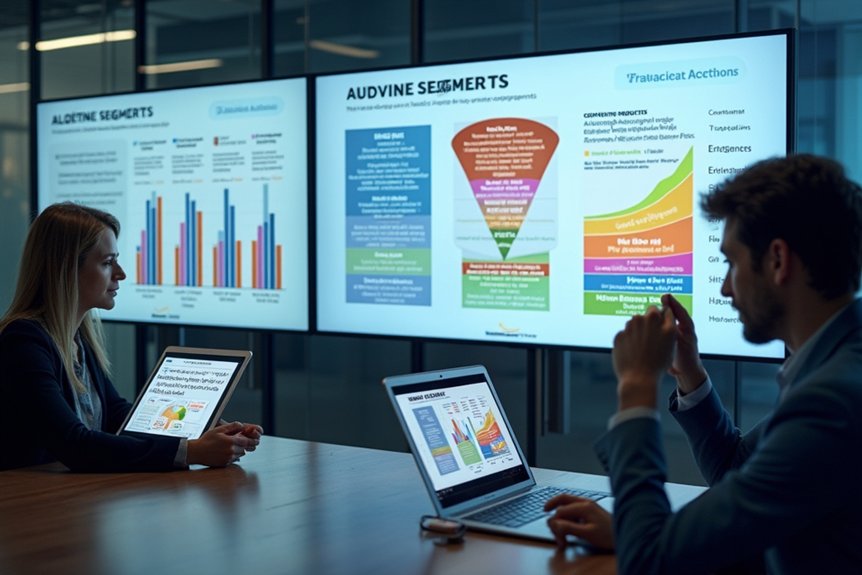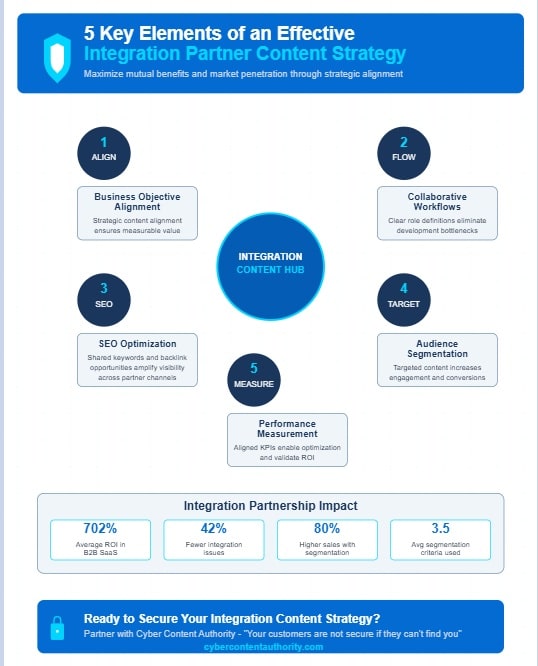An integration partner content strategy requires a strategic content alignment to maximize mutual benefits and market penetration. Organizations that implement the five key elements—business objective alignment, collaborative workflows, SEO optimization, audience segmentation, and performance measurement—consistently outperform competitors in digital visibility and conversion rates. These fundamental components, when executed systematically, create a framework for sustainable partner content ecosystems that drive qualified traffic while reducing acquisition costs. The question remains: how can these elements be operationalized effectively within existing organizational structures to overcome traditional siloed approaches?
Key Takeaways
- Strategic alignment between content initiatives and overarching business objectives ensures integration partnerships deliver measurable value.
- Collaborative workflows with clear role definitions and stakeholder input eliminate bottlenecks in partner content development.
- Coordinated SEO strategies with shared keywords and backlink opportunities amplify visibility across partner channels.
- Targeted content addressing shared audience segments increases engagement and conversion rates for all integration partners.
- Performance measurement with aligned KPIs enables continuous optimization and validates ROI of partnership content initiatives.
Aligning Content Strategy With Partner Business Objectives

The cornerstone of an effective integration partner content strategy lies in its deliberate alignment with overarching business objectives, which establishes the foundation for all subsequent content development and distribution efforts.
Through extensive stakeholder engagement and regular strategic reviews, organizations can guarantee content clarity while maintaining focus on defined business goals. Additionally, 69% of digital marketing specialists opt for ChatGPT due to its availability, highlighting the importance of utilizing AI tools in content strategy.
Moreover, by conducting thorough audience insights analysis, content strategists can develop materials that simultaneously address partner objectives and target audience needs.
Deep audience understanding creates content that bridges partner goals with customer priorities
Implementing SMART goals for content initiatives ensures specific and measurable outcomes that can be effectively tracked and optimized over time.
When executed properly, this alignment creates a symbiotic relationship between content initiatives and business growth metrics, ultimately driving engagement, conversion, and measurable return on investment across multiple distribution channels.
Building Collaborative Content Workflows for Maximum Impact
Establishing robust, collaborative content workflows represents a critical foundation for organizations seeking to maximize the impact of their integration partner content initiatives, particularly when diverse stakeholders with varying priorities must coordinate their efforts effectively. Through structured content brainstorming sessions and systematic workflow optimization techniques, teams can eliminate bottlenecks that typically impede productivity. The implementation of clear communication throughout each phase aligns team members with shared goals and enhances overall project outcomes. Additionally, with over 7 billion searches conducted on Google daily, the need for effective content strategies has never been more pressing.
| Workflow Phase | Key Components | Technology Enablers |
|---|---|---|
| Planning | Clear objectives, role definition | Project management tools |
| Creation | Templates, guidelines, SEO alignment | Cloud-based platforms |
| Review | Peer feedback, stakeholder input | Rich text editors with tracking |
| Approval | Quality checks, brand consistency | Asynchronous feedback systems |
| Distribution | Channel-specific formatting, metrics | Analytics integration |
These collaborative frameworks, when properly implemented, facilitate seamless coordination between integration partners while maintaining scalability for future content initiatives.
Optimizing Cross-Promotional SEO Opportunities
While organizations increasingly recognize the strategic value of integration partnerships, maximizing cross-promotional SEO opportunities requires deliberate alignment of keyword strategies, content architectures, and performance metrics across multiple stakeholder platforms.
Effective implementation hinges on enhancing cross-channel visibility through strategic deployment of high-quality backlinks, relevant keywords, and optimized video content that resonates across digital touchpoints. Furthermore, link-building strategies are essential for ensuring lasting impact and relevance in search rankings.
Organizations must prioritize mobile optimization, given that 39% of marketers consider keyword optimization essential, while simultaneously developing localized content tailored to specific geographic targets.
Moreover, social media SEO integration, incorporating industry-specific hashtags and regionally relevant terminology, can greatly amplify cross-promotional efforts when systematically aligned with broader content objectives.
With integration partners seeing an average ROI of 702% in B2B SaaS sectors, strategic SEO collaborations represent a high-value investment opportunity with relatively short breakeven periods.
Targeting Shared Audience Segments With Tailored Content

Nearly 80% of companies implementing strategic audience segmentation report substantial increases in sales performance, underscoring the critical importance of developing precisely tailored content that resonates across shared demographic and psychographic dimensions.
When integration partners identify shared interests between their respective audiences, they establish foundational elements for cross-promotional success that transcends traditional marketing boundaries.
Sophisticated audience alignment strategies, incorporating multiple data types beyond basic demographics, enable partners to craft messaging that addresses specific pain points and behavioral triggers. The average company now employs 3.5 different criteria when segmenting their customer base for targeted marketing initiatives.
This results in considerably higher engagement metrics and conversion rates compared to generalized content approaches.
Measuring Integration Success Through Content Performance Metrics
The evolution from tailored audience content to quantifiable performance measurement represents the foundation of sustainable integration partnerships, enabling organizations to verify ROI and identify optimization opportunities beyond subjective assessments.
Successful integration measurement requires establishing clear KPIs aligned with business objectives, whereby organizations implementing consistent monitoring protocols experience 42% fewer integration issues.
Performance analytics tools, such as Acrolinx, facilitate rigorous data quality assessments yielding 70% immediate error reductions, while content engagement metrics—including page views, conversion rates, and average session duration—provide critical insights into audience resonance.
Additionally, operational efficiency indicators, such as data synchronization accuracy and user adoption rates, serve as definitive integration success markers, contextualizing content performance within broader business impact frameworks. Companies should prioritize dashboard consolidation through platforms like Endgrates to maximize visibility across all integration metrics.
Leverage These Integrated Partner Content Strategies to Promote Your Website Today!
Integration partner content strategies, when meticulously crafted around business alignment, collaborative workflows, SEO optimization, audience segmentation, and performance measurement, create significant competitive advantages in today’s digital marketplace. Organizations that systematically implement these five foundational elements, while continuously refining their approach based on quantifiable metrics and evolving market conditions, position themselves for sustainable growth through enhanced visibility, engagement, and conversion rates across integrated channels.

Frequently Asked Questions
How Quickly Will Integration Content Impact Our Search Rankings?
Search rankings impact timeline varies from days to weeks, depending on site authority and keyword competition. Well-optimized integration content with strong performance signals accelerates visibility in competitive environments.
Who Owns the Content Created in Integration Partnerships?
Content ownership in integration partnerships depends on partnership agreements. Typically, it’s defined by predetermined terms specifying whether content is jointly owned, exclusively licensed, or divided between collaborating entities.
Can Integration Content Cannibalize Our Existing SEO Efforts?
Integration content can indeed cannibalize existing SEO efforts when multiple pages compete for identical keywords. Organizations must strategically differentiate integration content through focused keyword segmentation to prevent harmful keyword competition and diluted search rankings.
Which Platforms Work Best for Saas Integration Content?
For SaaS integration content, Zapier and HubSpot lead in platform selection due to their automation capabilities, while ContentCal and DivvyHQ optimize diverse content formats through streamlined workflow orchestration and distribution analytics.
How Do We Handle Conflicting SEO Keywords Between Partners?
Organizations should implement collaborative keyword mapping and keyword prioritization strategies to systematically identify overlaps, establish hierarchies based on strategic importance, and allocate specific terms to appropriate pages, avoiding diluted search visibility.

